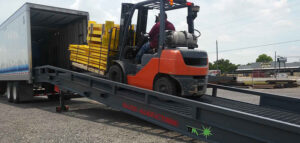 A yard ramp is one of the most practical tools for moving cargo between ground level and a truck, trailer, or dock. Warehouse managers and logistics coordinators will appreciate the efficiency gains from smooth, uninterrupted loading cycles. Forklift operators and yard personnel benefit from equipment that is predictable, stable, and built for daily heavy use. Safety officers can confidently document training compliance, while facility owners without permanent docks gain a flexible, cost-effective alternative to major construction.
A yard ramp is one of the most practical tools for moving cargo between ground level and a truck, trailer, or dock. Warehouse managers and logistics coordinators will appreciate the efficiency gains from smooth, uninterrupted loading cycles. Forklift operators and yard personnel benefit from equipment that is predictable, stable, and built for daily heavy use. Safety officers can confidently document training compliance, while facility owners without permanent docks gain a flexible, cost-effective alternative to major construction.
Brazos Manufacturing yard ramps are designed with strength, stability, and ease of operation in mind, but proper setup and use are essential to get the best performance from your equipment. To do that, every operator should follow a consistent process. Here are nine key steps that ensure safe, effective yard ramp use from start to finish.
1. Position the Ramp
Begin by moving the yard ramp into place. If you’re using a mobile model, use the tow bar or forklift pockets to position it so the ramp’s lip rests squarely on the edge of the trailer or dock. The alignment should allow forklifts to approach in a straight line, reducing the risk of swerving or misalignment while on the incline.
2. Secure the Ramp
Once the ramp is in position, attach the included safety chains to the trailer or dock. This step prevents the ramp from shifting during use. Movement can create dangerous gaps or uneven transitions. Never operate a forklift on a ramp that has not been properly secured.
3. Adjust the Height
The standard Brazos yard ramps feature a geared manual leg set that hand cranks to raise and lower the overall height of the ramp. Correct height adjustment ensures a smooth, stable transition for forklifts and minimizes equipment strain.
4. Inspect the Surface
Before loading, take a moment to check the ramp’s surface. Brazos ramps use heavy-duty steel grating to provide traction for forklift tires, even in wet conditions. Remove any debris, ice, or obstructions to ensure the tires maintain contact and grip during operation.
5. Begin Loading or Unloading
With the ramp secured and inspected, forklifts can begin moving cargo. Drive at a steady, controlled speed, avoiding sudden stops, starts, or turns while on the ramp. Maintain a straight path up and down the incline and ensure the forklift forks are kept low for better stability.
6. Observe Load Limits
Always check the ramp’s load capacity before use. Our steel yard ramps are rated for 16,000, 20,000, 25,000, 30,000, and 40,000 pounds, including both the forklift and its cargo. Exceeding this limit can damage the ramp and create unsafe conditions.
7. Maintain Clear Communication
If more than one person is involved in the operation, like a spotter on the ground, maintain clear communication. Hand signals or radios can help coordinate movement and avoid unexpected starts or stops.
8. End-of-Shift Checks
After loading or unloading is complete, lower the ramp, detach the safety chains, and move the ramp to its storage position if it’s a mobile model. A quick visual inspection for any damage will help catch issues before the next shift.
9. Beginning-of-Shift Checks
Don’t take for granted that the last person to use the yard ramp left it ready to use. At the beginning of a shift, operators should look for loose chains, bent side rails, or worn surfaces. These small checks can prevent costly downtime and accidents. Safety officers can also incorporate yard ramp operation into onboarding and refresher training sessions, ensuring every operator understands not just the “how” but also the “why” behind each step.
Why Process Matters
Following this sequence not only keeps operations running smoothly but also aligns with OSHA safety expectations. Securing the ramp, staying within capacity limits, and inspecting equipment before each shift are simple habits that protect both personnel and assets.
If your facility needs a reliable solution for bridging ground and trailer, let Brazos Manufacturing help you find the right yard ramp for your needs. Contact us today!